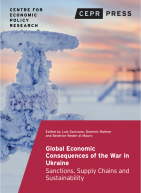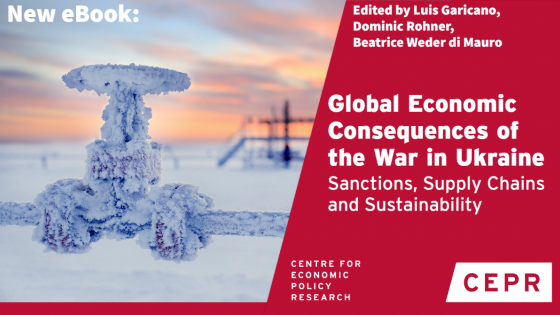War and climate change are existential threats to humanity. Misfortunes never come alone, and these two uber-threats are connected and intertwined, since a fossil fuel-driven economy results in global warming, which is a key factor in exacerbating conflict risks. Future historians looking back at the tragedy of the war in Ukraine may find that this was the time dependence on fossil fuels became, finally, unacceptable. The unprecedented heat waves experienced in the summer of 2022 in the Northern Hemisphere brought home the emergency that is global warming. The war made clear, further, that dependence on fossil fuels entails large political costs.
Hence, the war may accelerate the European energy transition in the longer run. Yet, the short-run effect is a sharp increase in the prices of oil and gas and an acute sense of insecurity and of being at the mercy of Russia. The European electricity market is integrated, and this has meant that even countries that do not depend on Russian gas (like Spain, for example) have been affected by higher electricity prices. This differential exposure to energy suppliers and sources is proving to be a test of European unity even ahead of the next winter. The proposal by the European Commission that all countries should reduce their energy use by 15% to be able to face the higher demand in winter met with resistance and was eventually agreed only with large concessions.
The green transition will be an enormous task which will take decades to complete. In this column, adapted from our concluding chapter in a new eBook (Garicano et al. 2022), we focus on short- and medium-run policy reactions in European economies. This does not mean that advanced technological and long-run measures are less relevant – they are equally important but simply beyond the scope of the current contribution. Below we first establish the link between global warming and conflict.
Why global warming makes conflict more likely
The presence of natural resources such as oil, gas, and minerals has been found to exacerbate conflict risk (Ross 2012, Dube and Vargas 2013, Caselli et al. 2015, Berman et al. 2017). This direct detrimental effect has been detected for the local environments where extraction takes place. However, there are further, indirect pitfalls of a fossil fuel-dependent economy, through greater global warming. Among many others, Hsiang et al. (2013), Burke et al. (2015) and Eberle et al. (2020) have shown that temperature spikes have a causal impact on increasing the risk of armed violence.
European and other democracies’ current dependence on fossil fuel puts several autocratic leaders in a position to benefit directly from a surge in gas and oil prices triggered by a conflict. When the leader of a petrostate invades a neighbouring country, energy price spikes may be so substantial that additional revenues more than compensate for the direct costs of the war. Consumers around the world unwillingly end up financing the war. Being addicted to fossil fuel means that resource wars are de facto subsidised – hardly a promising avenue for peace.
Reducing fossil fuel dependence I: Curbing energy demand for heating
A key domain in which large energy savings could be realised is household heating. First, many houses and offices are over-heated, which is not only bad for the environment (in terms of CO2 emissions), but also bad for health (e.g. Ponsonby et al. 1992). Reducing room temperature by 2°C in the winter would, according to estimates, reduce heating consumption by a very sizeable 26% (Palmer et al. 2012). Second, many houses are under-insulated. A representative, cross-European study found that in the leading country, Norway, the heat loss through the house envelope was more than three times smaller than in the laggard countries like the UK, and that old houses can feature heat losses that are five time as large as new dwellings.
The reason why market forces fail and there is under-insulation and over-heating is obvious. There is a clear externality, as the house occupiers only pay the private monetary cost of heating gas or fuel, without considering the large social costs in terms of pollution and CO2 emissions. Admittedly, some countries have put in place a Pigovian tax on heating gas and fuel that reduces the wedge between private and social costs of heating, but in most cases the tax is way too low (Caselli et al. 2021). One challenge for increasing levies on fuels and CO2 emissions is popular acceptance (Douenne and Fabre, 2022). Still, while challenging, several feasible policy measures seem promising, as discussed below.
Policy recommendation 1: Use targeted transfers to compensate the rise in prices of fuel, gas, and electricity. Do not use retail price regulation or blanket subsidies.
Several European governments have been reluctant to pass on higher wholesale gas and electricity prices to households. Not passing on increasing wholesale prices to the retail sector means that either energy providers or the budget are bearing the cost. The measures are fiscally unsustainable, and they send the wrong signal to households. The right signal should consist of two parts: first, poor and severely affected households will be protected temporarily from the consequences of the war through targeted transfers; second, higher prices for brown energy are here to stay, so adaptation investment in clean electricity and insulation should be accelerated.
Policy recommendation 2: Announce a post-war brown energy, heating gas and fuel levy. Tax revenues to be fully distributed to citizens, typically in a progressive way.
While emissions trading and Pigovian CO2 taxes could all work to internalise externalities, a key issue is social acceptance. One option is a bonus-malus invoice for each household, where either they have to pay or they receive a transfer, depending on their consumption. To boost social acceptance of such a levy, it could be made revenue neutral, labelled a ‘climate dividend’ and designed in a progressive, redistributive way to ensure that the policy is not perceived as ‘another tax burden’ and that no situation arises where ‘only the rich can afford heating’. As found in Carattini et al. (2019), well-designed and communicated levies can gain popular support.
Policy recommendation 3: Subsidising renovation and envelope isolation.
Due to the externality, houses tend to be under-insulated. And additional externalities arise when the person paying the heating costs is not the one deciding on renovation. For example, owner-occupied dwellings are a fifth more likely to be better insulated (Gillingham et al. 2012). Subsidising envelope renovation can reduce these externalities and biases.
Reducing fossil fuel dependence II: Reinventing mobility
To reduce the carbon footprint from mobility, there are two options: travel less and travel greener. Concerning the first option, the Covid-19 pandemic has shown that many – though not all – meetings can be organised efficiently through online services such as Zoom. Hence, a simple policy angle could be the following:
Policy recommendation 4: Install a high-level working group to set recommendations and benchmarks for business travel, including the use of offsets.
A high-level working group composed of the representatives of the private sector, the public sector and international organisations could start the conversation about appropriate benchmarks and standards for business travel. It could create incentives to hold online meetings whenever feasible and efficient.
Travelling greener also implies substituting plane and car travel whenever possible by trains and other non-fossil fuel-driven forms of mobility (for example, within-city travelling by bike). Total emissions per person for a kilometre travelled are more than 40 times larger when travelled by plane than in a (modern) train. Within Europe most – if not all – international travel could be carried out by train if sufficient investments in modern high-speed and overnight trains were made.
Policy recommendation 5: Stop subsidising planes, start investing massively in trains.
At present, planes are implicitly heavily subsidised, as kerosene to a large extent escapes taxation, and environmental externalities are (almost) not internalised. The result is that often it is much cheaper to travel from A to B by plane than train – which completely distorts incentives.
Similarly, daily commuting can be made much greener.
Policy recommendation 6: Reduce the relative costs of electric cars with respect to fossil fuel based ones.
While most countries have some taxes on gasoline, they do not (in most cases) fully take into account the negative environmental externality of combustion engines. These distortions can be rectified by higher fuel taxes and/or subsidising of greener means of transport.
Reducing fossil fuel dependence III: Nudging energy savings in various household decisions
As stressed by Gowdy (2008), behavioural nudging strategies may be important to consider. Information provision may matter. For example, in a field experiment it was found that real-time feedback on resource consumption during showering reduced consumption by 22% (Tiefenbeck et al. 2018). Hence:
Policy recommendation 7: Stepping up information provision about resource emissions and CO2 emissions per activity.
Fostering green energy supply
The threat of being cut off from Russian gas has led to some paradoxical decisions. For instance, the German Minister of Energy had to propose emergency legislation to reactivate mothballed coal (lignite) plants – coal being the biggest contributor to global warming per unit of electricity produced. Policymakers must work hard to convert this step in the wrong direction into an opportunity eventually.
Policy recommendation 8: Any short-run reintroduction of highly polluting energy sources to replace Russian oil and gas must be (1) explicitly temporary and (2) conditional – in exchange for clear commitments from the broad spectrum of industry and other interests on the elimination of obstacles to the installation of wind and solar energy plants.
An alternative exists, at the very least for electricity generation, in the form of nuclear, which does not contribute to global warming but entails a small risk of nuclear accidents and creates radioactive waste. The International Energy Agency (2022) has estimated that the 413 GW of nuclear energy that are in operation today contribute to the elimination of 1.5 gigatonnes of global emissions and 180 billion cubic metres of gas. This industry, with suitable regulatory changes, may make (in the short run) a sizeable contribution to solving the two key crises the world is confronting: the war (and its associated energy crisis) and climate change.
The first avenue recommended by a recent IEA (2022) report is extending the life of nuclear plants. Around one-third of existing capacity in advanced economies is scheduled to close by 2030. The IEA estimates that life extension allows electricity to be produced safely at a cost of well below $40 per MWh. This suggests that closing down nuclear plants as quickly as possible is not the right response at this stage.
Policy recommendation 9: Extend plant lifetimes when safely possible, and limited to the short run, to navigate through the current crisis.
Finally, Europe must be able to deal with this crisis together. One of the largest risks Europe faces over the next months and years is a breakdown in solidarity, as Russian gas supplies run out and oil sanctions are implemented. The “joint purchasing platform” agreed by the Council on 25 March has not yet been put in place and the crucial REPower EU instrument announced on 8 March by the European Commission is bogged down in Council and Parliament and appears unlikely to be approved in time to help with the current stage of the crisis.
In the pipeline gas market there is market power, in principle, at both ends of the pipeline. Russia has been fully exercising its market power. European buyers have been competing to secure storages and have been driving up wholesale prices (of gas and electricity). Europe should unite behind a single buyer for pipeline gas, which could exercise own market power by controlling an offer price (say, €100/MWh).
Policy recommendation 10. The EU must recover the urgency of the initial post-pandemic period to ensure a truly European response to the energy crisis, so far absent, including (1) investing in emergency interconnections of gas and electricity; (2) joint purchase and storage of gas; and (3) a fiscal solidarity mechanism able to cushion the blow of the crisis to the most vulnerable countries and citizens.
References
Berman, N, M Couttenier, D Rohner, and M Thoenig (2017), "This mine is mine! How minerals fuel conflicts in Africa", American Economic Review 107(6): 1564-1610.
Burke, M, S M Hsiang, and E Miguel (2015), "Climate and Conflict”, Annual Review of Economics 7(1): 577-617.
Carattini, S, S Kallbekken, and A Orlov (2019), "How to win public support for a global carbon tax”, Nature 565: 289-291.
Caselli, F, A Ludwig and R van der Ploeg (eds) (2021), No Brainers and Low-Hanging Fruit in National Climate Policy, CEPR Press.
Caselli, F, M Morelli, and D Rohner (2015), "The geography of interstate resource wars”, The Quarterly Journal of Economics 130(1): 267-315.
Douenne, T, and A Fabre (2022), "Yellow vests, pessimistic beliefs, and carbon tax aversion”, American Economic Journal: Economic Policy 14(1): 81-110.
Dube, O, and J F Vargas (2013), "Commodity price shocks and civil conflict: Evidence from Colombia”, The Review of Economic Studies 80(4): 1384-1421.
Eberle, U J, D Rohner, and M Thoenig (2020), "Heat and Hate: Climate Security and Farmer-Herder Conflicts in Africa”, CEPR Discussion Paper 15542.
Fowlie, M, C Wolfram, P Baylis, C A Spurlock, A Todd-Blick, and P Cappers (2021), "Default effects and follow-on behaviour: Evidence from an electricity pricing program”, The Review of Economic Studies 88(6): 2886-2934.
Garicano, L, D Rohner and B Weder di Mauro (2022), Global Economic Consequences of the War in Ukraine: Sanctions, Supply Chains and Sustainability, CEPR Press.
Gillingham, K, M Harding, and D Rapson (2012), "Split incentives in residential energy consumption”, The Energy Journal 33(2).
Gowdy, J M (2008), "Behavioral economics and climate change policy”, Journal of Economic Behavior & Organization 68(3-4): 632-644.
Hsiang, S M, M Burke, and E Miguel (2013), "Quantifying the influence of climate on human conflict”, Science 341(6151): 1235367.
IEA – International Energy Agency (2022), Nuclear Power and Secure Energy Transitions: From Today’s Challenges to Tomorrow’s Clean Energy Systems, June.
Palmer, J, N Terry, and P Pope (2012), How much energy could be saved by making small changes to everyday household behaviours, A report for Department of Energy and Climate Change.
Ponsonby, A-L, T Dwyer, L E Gibbons, J A Cochrane, M E Jones, and M J McCall (1992), "Thermal environment and sudden infant death syndrome: case-control study”, British Medical Journal 304(6822): 277-282.
Ross, M L (2012), "The oil curse”, in The Oil Curse, Princeton University Press.
Tiefenbeck, V, L Goette, K Degen, V Tasic, E Fleisch, R Lalive, and T Staake (2018), "Overcoming salience bias: How real-time feedback fosters resource conservation”, Management Science 64(3): 1458-1476.





